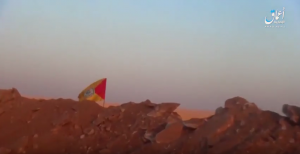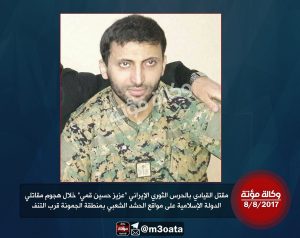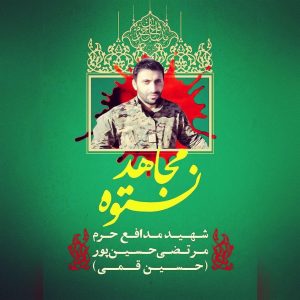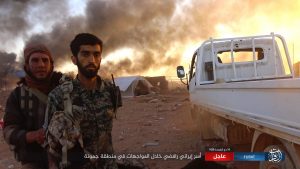The Seyyed al Shuhada Brigades, an Iraqi-Shiite militia controlled by Iran’s Islamic Revolutionary Guard Corps (IRGC), claimed yesterday that its forces came under fire from American artillery shells in the vicinity of Jamouna, Syria.
A US Defense spokesman has rejected the allegation.
Jamouna is located approximately eight miles from the Iraqi border and 37 miles northeast of Tanf, where a US military base is located. The Islamic State has posted footage of a raid in that area on the same day that shows the Shiite militia’s flag, strongly suggesting an attempt by the Shiite-jihadist militia to cover up an attack by the Sunni-jihadist group, muddy the waters and shift the blame to the United States.

Flag of the Seyyed al Shuhada Brigades seen in the Islamic State’s raid video.
The Iraqi militia said more than 40 had been killed and injured, and the Islamic State claimed to have killed 68. Iranians are among the dead.
The Seyyed al Shuhada Brigade initially published a statement claiming US artillery shells struck forces positioned between Syria’s Jamouna and Iraq’s Akashat, which is in the western portion of Anbar province. Iranian media reported it as US jet strike. The Secretary General of the militia, Abu Aala al Walayi, confirmed the numbers to IRGC-affiliated Tasnim News, adding that “seven of our brothers in the Guard Corps” were also killed.
Al Walayi later changed his account of the story, however. He said forces were undertaking “clearing” operation between Akashat and east of Tanf, and were struck by US artillery shells, as well as fighter jets. He claimed his forces have video proof. The militia chief then accused the US of coordinating with the Islamic State and that the group attacked “precisely after the heavy bombardment by the Americans” from “the Americans’ security zone,” meaning the deconfliction area.
The IRGC and militias have long accused the US of directly support the Islamic State. The Iraqi militia chief claimed his forces had provided “information about the cleared area to the Syrian army and Russian forces.”
Al Walayi stressed the border clearing operation is “more important” than Tal Afar, a besieged town to the west of Mosul, due to the border town’s “special position.” His militia fights under the banner of the Popular Mobilization Forces (PMF), which is “a legal institution like the Iraqi army and Federal Police.” The militia leader claimed he has asked Iraq’s joint command headquarters to investigate the “great catastrophe.”
The Islamic State has claimed the deaths of two Revolutionary Guard operatives during the raid. Iran has thus far acknowledged the death of a colonel and the photos provided by Iran and the Islamic State match. Al Walayi confirmed the death of that senior commander, who went by the alias of “Hossein Qomi,” calling him a commander with more than four years of experience in Syria who was “responsible for commanding and leading forces in the area.” His death led to disruption “in the coordination of our forces,” the militia chief added.

The Islamic State’s claim of killing Revolutionary Guard commander “Aziz Hossein Qomi.”

Funeral poster of Morteza Hosseinpour-Shalmani (AKA Hossein Qomi).
Iranian military officials and media are offering little information about the senior officer who was killed in the raid, though some officials are saying he was a member of the Qods Force, the Guard’s external operations branch.
Col. Morteza Hosseinpour-Shalmani, “a Guardsman and Gilani shrine defender of the corps’ Qods Force,” was killed in Syria during an “advisory” mission fighting “takfiri DAESH [Islamic State]” forces, according to a Revolutionary Guard official from the Ground Forces’ Qods Corps of the northern Gilan province (not to be confused with the Qods Force). The media report citing the official quotes him as saying Hosseinpour-Shalmani was a part of the “Qods Force,” though Iranian media have frequently reported that and the Gilan unit as the same.
The report, however, distinguishes between the Qods Force and the Qods Corps, referring to the said official as the “deputy coordinator of Gilan’s Qods Corps.” Tasnim News’ report citing another local official makes the same distinction, adding Hosseinpour-Shalmani was residing in Qom province, central Iran, perhaps explaining why he took the alias of “Qomi.” If he were attached to the Gilan provincial unit, he would have resided in the province.
A Qods Corps official today said the colonel was killed in Syria’s Deir Ezzor province and is to be buried in his home county of Shalman in Gilan this week.
The Revolutionary Guard divides its Ground Forces units by provinces.
A Guard-affiliated outlet claimed the officer was killed near Palmyra in central Syria, and another state-affiliated outlet claimed he was killed in eastern part of the central Homs province, where the ancient city of Palmyra is located. Pro-Syrian regime forces are operating in the area to take Suknah, to the east of Palmyra, from the Islamic State. Guard-affiliated media have been covering this battle.
The Sunni-jihadist group has posted another footage of whom they claim is an Iranian captured during the raid, subsequently showing his beheaded body (not shown here). Iran has yet to confirm that individual’s death.

The Islamic State claimed to have captured an Iranian prisoner during the raid. His tag reads in Persian, “young [ineligible].”
Guard Corps commanders not only advise militias in Syria but have directly led them in combat. Lower-ranked Iranian operatives from the Ground Forces have been previously embedded among Shiite militiamen as components of the expeditionary forces led by the Qods Force.
In May and June, Tehran-led forces including the Seyyed al Shuhada Brigades challenged a US de-confliction zone near Tanf, triggering US strikes. The militia is part of a wider Iranian-backed operation to control the Iraqi-Syria border and deny that area to US-backed forces. [See FDD’s Long War Journal report, Iran tests the US in southeastern Syria.]
The Islamic State’s footage of this week’s raid:














2 Comments
The fog of war is now a huge sand storm .
The Haboob of war?